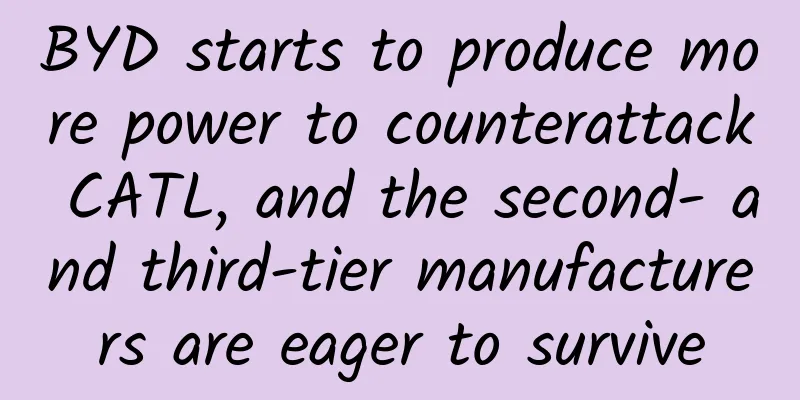BYD starts to produce more power to counterattack CATL, and the second- and third-tier manufacturers are eager to survive

|
In 2018, the fierce battle between CATL and BYD continued in the Chinese power battery market. Against the backdrop of structural overcapacity, some small and medium-sized enterprises sought alternative solutions, while others rushed to go public, hoping that they would not become another Watma before the end. With a sharp increase in production capacity, BYD is both on the offensive and defensive In 2018, BYD's production capacity expanded rapidly. In June, the first phase of BYD's Qinghai Nanchuan battery factory with a capacity of 10GWh was put into production, and the remaining 14GWh capacity will be put into production in 2019. In July, BYD and Changan Automobile signed an agreement to jointly establish a joint venture in Chongqing Liangjiang New District to plan a power battery project with a capacity of 10GWh. In August, BYD signed a 20GWh investment cooperation agreement with the Chongqing Bishan District Government, with a total investment of 10 billion yuan. On September 9, BYD signed a 30GWh power battery project with Xi'an High-tech Zone, with a total investment of 12 billion yuan. BYD Qinghai Power Battery Factory BYD is trying to achieve a total power battery production capacity of 60GWh in 2020, surpassing CATL's planned 54GWh and becoming the largest power battery manufacturer in terms of production capacity. When all of these planned capacities are put into production, together with BYD's existing 26GWh capacity, BYD's total capacity will exceed 100GWh. BYD's rapid expansion of production capacity is an effort to give play to the scale effect of the power battery industry, while complying with the clustering effect of leading manufacturers under the subsidy reduction. Manufacturers with technological advantages like BYD can further reduce costs by expanding production, and on the other hand, the existence of backward production capacity also provides space for BYD's smooth expansion. After 2020, the entry of Japanese and Korean manufacturers with technological advantages is also a potential threat. In order to build a deep enough moat before foreign giants enter, BYD also needs to prepare for a rainy day in terms of production capacity. Not only BYD, but also CATL, the power battery "big brother" listed on the Growth Enterprise Market on June 11 this year, also revealed its expansion plan in its prospectus. Its investment project of 9.86 billion yuan, the annual production capacity of the Huxi lithium-ion power battery production base, will reach 24GWh, and the construction period will be 36 months. As the Chinese power battery market is likely to enter a subsidy-free era in 2020, foreign manufacturers are also gearing up through active capacity layout. SK Innovation Group plans to build a power battery plant with an annual production capacity of 7.5GWh in Jintan Development Zone, Changzhou, China. LG Chemical signed a battery project with Nanjing Jiangning Binjiang Development Zone, with a total investment of US$2 billion. It is planned to start mass production in 2019 and reach full production in 2013, with an annual production capacity of 32GWh. Samsung SDI also plans to set up a new power battery plant in Wuxi, and has completed company registration in January this year. BYD surpasses CATL? In the first half of 2018, CATL's power battery shipments accounted for 41.6% of the total shipments, BYD accounted for 21.4%, and the total accounted for 63%. Entering the second half of the year, BYD's market share seems to be approaching CATL. In July, BYD's market share was 24.6%, and CATL's was 40.7%, one rising and the other falling. By August, BYD's market share reached 27.8%, further narrowing the gap with CATL's 35.31%. However, the shipments of 1 or 2 months are relatively accidental and cannot explain the trend. In April of this year, BYD's installed capacity for the month reached 1.34GWh, even exceeding CATL. However, the long-term data in the first half of the year still shows the strong position of CATL. Ranking of installed capacity of battery companies and their main customers in August 2018 BYD's rapid growth in market share is due to the high sales growth of its own new energy vehicles. According to BYD's sales report in August 2018, the sales of new energy passenger vehicles were 20,845, an increase of 85% year-on-year. According to the statistics of the China Passenger Car Association, the sales of new energy vehicles in the country in August were 84,000, an increase of 61.7% year-on-year. After the new energy bus market suffered a severe blow from the subsidy review, BYD was able to grow at a higher rate than the market average in the passenger car market, which really helped its own power battery business a lot. On the other hand, BYD changed its previous closed strategy of supplying only its own new energy vehicles in the power battery market and began to frequently cooperate with automobile manufacturers. In addition to Changan Automobile, which has already signed a contract, Dongfeng and Great Wall are also actively contacting them. These car manufacturers, eager to find new suppliers outside of CATL to spread risks, have become the source of BYD's strong growth. BYD, which once held the dominant position in China's battery industry for a long time, insisted on the technical route of lithium iron phosphate. In 2017, when the stricter subsidy review dealt a heavy blow to the bus market, CATL, which relied on the "lithium iron phosphate + ternary materials" technology, overtook it in one fell swoop by relying on the new energy passenger car market. Stubborn BYD once used lithium iron phosphate batteries in its own passenger cars. However, the development of ternary material batteries has exposed the shortcomings of lithium iron phosphate batteries, which have poor endurance. In 2017, BYD announced that its passenger cars would be fully switched to ternary materials. In order to continue the full industry chain strategy, the power battery business focusing on lithium iron phosphate batteries was also forced to adjust to take into account both ternary materials and lithium iron phosphate. Before the Qinghai project was completed, BYD's total power battery production capacity was 10GWh of lithium iron phosphate and 6GWh of ternary materials. The 24GWh production capacity of the Qinghai project is all ternary batteries, which shows BYD's determination to go all in on ternary materials. BYD Battery Business Group CEO He Long plans to achieve a ternary lithium battery energy density of 260Wh/kg in 2019, while CATL Vice Chairman Huang Shilin has set the 2019 target at 270Wh/kg. CATL seems to be more confident in technology, but overall the two companies are on par in terms of power battery technology. After BYD opens up its power battery business, it should be able to narrow the gap with CATL in market share, but whether it can shake CATL's number one position is still unknown. In the absence of new technologies to achieve overtaking, even if BYD splits up or even lists its power battery business separately, this independent incentive mechanism will hardly help BYD catch up with CATL in technology. However, the financing after the independent listing can greatly alleviate BYD's financial problems. In the latest second quarter 2018 financial report, although the cash flow generated by BYD's operating activities has greatly improved, with a year-on-year increase of more than 50%, the non-net profit has changed from 1.12 billion yuan in the same period last year to a loss of 673 million yuan today, and the current ratio and quick ratio are both below 1. Fortunately, the revenue still has a high growth of 20%, and the short-term liquidity problem can also be solved by issuing bonds. Since 2018, BYD has issued three phases of ultra-short-term financing bonds totaling 5.5 billion yuan. When the third phase of financing bonds was issued on August 15, BYD's main long-term credit rating was still AAA. Small and medium-sized manufacturers: Should we continue with 2VC or explore new markets? Many of the other top ten manufacturers besides the two are also expanding their production. Lishen plans to increase its production capacity from the current 10GWh to 30GWh by 2020. Guoxuan High-tech plans to increase its production capacity from the current 6.5GWh to 13-14GWh by the end of 2018. Farasis Energy signed a contract for a 20GWh annual power battery project in Zhenjiang, Jiangsu. It is difficult to explain their behavior by grabbing market share from backward production capacity. Most of these manufacturers are also using ternary materials and lithium iron phosphate, so there is no differentiation. The market share of the top ten has exceeded 90%, and there is little market left for them to lag behind. Therefore, the expansion plans of these manufacturers are basically preparations for further financing. Farasis Energy completed rounds B, C, and D financing from December 2017 to May 2018, with round C financing reaching 5 billion yuan. It looks like a sprint for listing. Tianjin Lishen also announced that it will go public through a backdoor listing of ST Jialing. Both companies hope to maximize their valuations, so they are very motivated to expand production under the influence of capital. Guoxuan High-tech, a listed company, has also raised funds through equity pledges, so announcing an expansion plan to stabilize the stock price is also the only choice. Data source: China Association of Automobile Manufacturers In addition to ternary materials and lithium iron phosphate, manufacturers are also insisting on lithium manganese oxide and lithium titanate. Xingheng Power, which makes lithium manganese oxide batteries, ranked among the top ten in terms of shipments in July 2018. Since lithium manganese oxide batteries have much lower specific energy than ternary material batteries, it is difficult for them to survive in the passenger car market. The once popular Nissan Leaf made the lithium manganese oxide batteries of Nissan's battery business unit AESC famous for a while. But now, the new Nissan Leaf has been replaced with ternary lithium batteries, and AESC has also been sold to China's Envision Energy Group. Xingheng Power's goal is to become a leader in the logistics vehicle segment. The long mileage of logistics vehicles during their life cycle determines that the use of low-cost lithium manganese oxide batteries is economically cost-effective. On the other hand, Xingheng has become a leader in the field of electric light vehicles. A large number of electric bicycles and electric motorcycles are using its lithium manganese oxide batteries. Dong Mingzhu's Zhuhai Yinlong is the company that insists on lithium titanate technology. Yinlong's lithium titanate technology is very advanced. Its holding company, Aoti Nanotechnology Co., Ltd. of the United States, is one of the only two companies in the world that has industrialized lithium titanate core technology (the other is Japan's Toshiba). However, although lithium titanate batteries have advantages such as high safety, good fast charging performance, long cycle life, and good wide temperature resistance, the disadvantage of too low energy density makes the range unguaranteed. Lithium titanate cannot be installed in passenger cars, so it can only focus on the bus market. Even in the bus market, for a conventional 10-meter new energy bus, the mainstream lithium titanate battery that can only run 80 kilometers with 80 degrees of electricity is far inferior to the mainstream lithium iron phosphate battery that can run 200 kilometers with 200 degrees of electricity. After the development of the bus market slows down, perhaps Yinlong's lithium titanate can only find a way out in the energy storage system that cooperates with new energy power generation. Second-tier manufacturers are also looking to the future. As the government's industrial planning requires the energy density of power batteries to reach 300Wh/kg by 2020, many manufacturers have placed their hopes on high-energy-density high-nickel batteries. BAK, which began researching the high-nickel 811 process as early as 2012, is the largest player in the domestic high-nickel 811 market. Its NCM811 products have been deployed in models of brands such as JAC, SAIC Maxus, BAIC Energy, Xiaopeng and Yundu. In addition, power battery manufacturers that have deployed NCA or NCM811 to support automakers include: Guoxuan High-tech, Dangsheng Technology, Yinlong, Lishen, and BYD. High-nickel batteries have greatly improved the specific energy of power batteries, but the current high-nickel batteries actually sacrifice safety and cycle life. If high-nickel batteries can replicate the performance of ternary materials with poor safety and high energy density to reverse the performance of lithium iron phosphate, the future power battery market will undoubtedly be reshaped. As a winner of Toutiao's Qingyun Plan and Baijiahao's Bai+ Plan, the 2019 Baidu Digital Author of the Year, the Baijiahao's Most Popular Author in the Technology Field, the 2019 Sogou Technology and Culture Author, and the 2021 Baijiahao Quarterly Influential Creator, he has won many awards, including the 2013 Sohu Best Industry Media Person, the 2015 China New Media Entrepreneurship Competition Beijing Third Place, the 2015 Guangmang Experience Award, the 2015 China New Media Entrepreneurship Competition Finals Third Place, and the 2018 Baidu Dynamic Annual Powerful Celebrity. |
<<: The suffering of Internet TV companies has just begun
Recommend
The inedible "tree lobster" survives on an isolated island
Lord Howe Island is a volcanic island located bet...
30 excellent copywriting sentences all use this technique
The next 30 sentences all use the same technique....
E-commerce live streaming | 2020 short video KOL live streaming e-commerce insight report
Today I’d like to share with you an analysis of h...
Event planning and promotion, how to plan and execute an event?
1. Event Planning Overview There are three keys t...
What happened to those who wore contact lenses for many years? 4 injuries are hard to avoid →
Many people are familiar with contact lenses, and...
Wu Hong: Mango TV big data platform architecture and basic component optimization
On August 29, 2015, Qiniu held the two-day Qiniu ...
Kuaishou advertising placement and advantages!
After placing Kuaishou ads, many advertisers will...
Startup products: How to scale up offline?
Recently, I have been learning how startups can s...
Tencent Micro Game Console Review: More Suitable for Heavy Mobile Game Players
Since the ban on game consoles was lifted, the ga...
National Health Commission: Patients visiting fever clinics need to undergo nucleic acid testing!
The National Health Commission issued a notice re...
Xiaohongshu’s hot-selling notes trends!
There were Labor Day and other promotional events...
The difference between programmers in large companies and programmers in small companies
Many college students hope to become a programmer...
Methods for quickly diverting traffic from Tik Tok to WeChat, summary of 6 practical cases!
Readers often ask: How to divert Douyin fans to W...
AutoNavi and DAMO Academy jointly launch in-car AR navigation, making driving easier
On October 17, AutoNavi Maps announced that it wo...
Entrepreneurship Yeast·Management Fermentation Card, a compulsory course for 100 million managers
Entrepreneurship Yeast·Management Fermentation Ca...




![[Smart Farmers] New technology helps microorganisms settle in water](/upload/images/67f224415f38f.webp)




